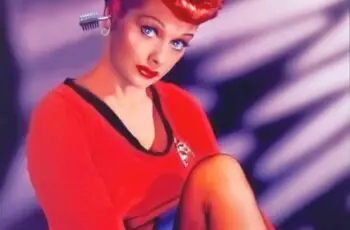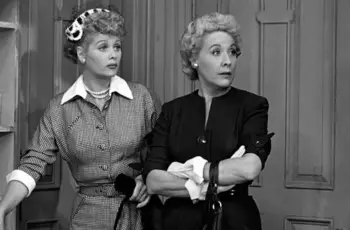The iconic television sitcom, ‘I Love Lucy’, first graced American screens in the 1950s and soon evolved to become a significant factor in shaping the societal perceptions of the era. As an epitome of wit, humor, and timeless appeal, the show offered a charming yet authentic portrayal of the American lifestyle during the post-war phase. Bridging the gap between mere entertainment and profound social impact, ‘I Love Lucy’ transcended traditional narrative techniques, presenting a unique exploration of marriage, friendship, pregnancy, and gender roles. An understanding of the 1950s American culture is necessary to truly appreciate the uniqueness of the show, its characters, and its storyline.
Overview of ‘I Love Lucy’
Concept and Characters of ‘I Love Lucy’
‘I Love Lucy’, created by Lucille Ball and Desi Arnaz, aired on CBS from 1951 to 1957. The show revolutionized the television sitcom genre with its innovative multi-camera setup and live audience recording format. The plot revolves around a nave yet ambitious housewife, Lucy Ricardo (played by Lucille Ball), her band-leader husband, Ricky Ricardo (played by Desi Arnaz), and their best friends and neighbors, Fred and Ethel Mertz (played by William Frawley and Vivian Vance). One of the many enduring features of I Love Lucy are the characters, which, although caricatured, reflect various aspects of human nature, thereby evoking empathy from the audience and therefore their enduring popularity.
Storyline and Thematic Elements of ‘I Love Lucy’
The narrative of ‘I Love Lucy’ often revolves around Lucy’s comic and oftentimes zany attempts at venturing beyond her domestic life. She repeatedly conspires to appear in Ricky’s nightclub act, despite Ricky’s clear disapproval. This results in Lucy developing elaborate schemes and disguises to circumvent Ricky, often enlisting Ethel’s help. The script cleverly uses the mundane setting of domesticity as a comedic stage, presenting a refreshing contradiction to the traditional roles of housewives in the 1950s.
Specific Episodes and Timeless Appeal
Some of the most beloved episodes include “Lucy Does a TV Commercial,” where Lucy gets progressively drunk on a health tonic she’s promoting, and “Job Switching,” in which Lucy and Ethel disastrously attempt to work in a candy factory. Not only do these episodes showcase Ball’s impeccable comedic timing and physical comedy skills, but they employ a certain level of social observation on roles of women during the 1950s. The humor lies in the incongruity of the situation and its departure from traditional norms.
‘I Love Lucy’ and 1950s Culture
The 1950s was a period of considerable change in American culture, punctuated by the shift towards more conservative familial values, economic prosperity, and the intense fear of communism (often referred to as the “Red Scare”). ‘I Love Lucy’ featured an interracial couple, with Cuban immigrant Ricky Ricardo’s character often poking fun at cultural misunderstanding and language barriers, thereby subtly highlighting the immigrant experience in America, a pertinent topic of the 50s. Additionally, the situational comedy also touched nerve on the emerging shift of societal mores, as traditional family roles were slowly but steadily being redefined.
The Phenomenal Influence of ‘I Love Lucy’
Aimed squarely at the hearts of the American public, ‘I Love Lucy’ became an incredible success during its original run and subsequent syndication. The show’s enduring popularity and far-reaching impact have solidified its place as one of the greatest television shows of all time. It set a precedent not just for future sitcoms by revolutionizing production techniques and narrative style, but also served as a powerful sociocultural tool. ‘I Love Lucy’ used its platform to reflect and critique societal behaviors and cultural norms of the time.
Impact of ‘I Love Lucy’ on American Society
‘I Love Lucy’: More Than Just Entertainment
Debuting on CBS in October 1951, ‘I Love Lucy’ initiated a seismic shift in American television. The beloved sitcom, featuring Lucille Ball and Desi Arnaz as the unforgettable Lucy and Ricky Ricardo, was far more impactful than a mere distraction. Its influence stretched beyond just entertainment, actively reshaping the American public’s ideas about some very important societal fixtures – marriage, friendship, pregnancy, and gender roles.
Groundbreaking Techniques
One of the most significant impacts ‘I Love Lucy’ had was its innovative techniques that set the standard for sitcoms that followed. The show was one of the first scripted television programs to be shot on 35 mm film in front of a live studio audience, at a time when most were broadcast live and lost to history. The use of three cameras became standard practice soon after. This technique provided better coverage of scenes, enhanced the comedic effect, and contributed to the show’s lasting popularity and continued syndication.
Unconventional Representation of Women
‘I Love Lucy’ was groundbreaking in its portrayal of women, particularly in the character of Lucy Ricardo. Lucille Ball’s character was more than just a homemaker or secondary character, albeit in a comedic manner, she aspired to branch out of her domestic sphere, seeking a career in show business. This representation was unconventional at a time when women were expected to confine themselves primarily to their homes. Lucy embodied the spirit of many American women who were gearing up to enter the workforce in significant numbers during the 1950s.
Influence on Perceptions of Marriage and Friendship
Abandoning the typical portrayal of ‘perfect’ marriage, ‘I Love Lucy’ depicted a more realistic relationship between Lucy and Ricky Ricardo. Their marriage was a partnership characterized by love, friendship, disagreements, and plenty of humorous moments. The Ricardos and their best friends, the Mertzes, demonstrated a strong sense of kinship and camaraderie that was relatable to the American public.
Groundbreaking Portrayal of Pregnancy
Lucy Ricardo’s pregnancy in the second season was a revolutionary moment in television history. The pregnancy was written into the show because Lucille Ball was pregnant in real life. At a time when it was taboo to even use the term ‘pregnant’ on television, ‘I Love Lucy’ broke the trend, celebrating the impending arrival of a baby. The sensitive portrayal of Lucy’s pregnancy and the anticipation leading up to Little Ricky’s birth constituted one of TV’s first story arcs and garnered high Nielsen ratings, further imprinting the sitcom in the American psyche.
Indelible Influence on American Television
‘I Love Lucy’, despite the conclusion of its initial airing, still casts a significant impact on modern American television. The focus on circumstantial comedy, unwavering friendship, a realistic display of marital life, and a humorous approach to tackling pivotal themes, all contribute to the enduring allure of ‘I Love Lucy’. It’s pervasive influence on subsequent sitcoms significantly paves the way for the transformation of sitcom storytelling to its contemporary form.
Contextualizing ‘I Love Lucy’ in the 1950s American Culture
The Era of Societal Transformation
The aftermath of World War II ushered in monumental societal overhauls within the United States. The influx of returning soldiers catalyzed a surge in population, culminating in the “Baby Boom,” which amended family dynamics nationwide. Traditional gender roles were reestablished, with men laboring outside the household while women were primarily consigned to homebound responsibilities. Such conditions gave rise to the archetype of the nuclear family composed of father, mother, and their offspring living under one roof in suburban America.
Flourish of the Entertainment Industry
This post-war period also marked the golden age of Hollywood and the birth of television as a dominant medium. The entertainment industry thrived as people sought distraction and entertainment from the aftermath of war. Musicals, comedies, and drama films enjoyed a high level of popularity. Many stars from this era, like Marilyn Monroe, Elvis Presley, and James Dean, still hold iconic status today. TV shows, a novel concept at the time, began to emerge as the centerpiece of American living rooms, bringing daily entertainment directly into homes.
Evolution of Television as a Dominant Medium
The growth of television culture in the 1950s played a significant role in shaping societal norms. Shows like “I Love Lucy” popularized the image of the American nuclear family. Television became a powerful tool for advertising, further promoting consumer culture. By the end of the decade, televisions were a staple in almost all American homes, reinforcing its place as a dominant societal and cultural medium.
I Love Lucy Impact and Uniqueness
“I Love Lucy”, which aired from 1951 to 1957, broke many barriers for its time. The show was innovative with its use of a live audience, multiple cameras, and film negatives for re-runs. It confronted societal norms by featuring an interracial couple, a Cuban bandleader, and a red-headed housewife, as main characters. The show’s depiction of a woman challenging traditional gender roles, venturing outside her home to work and participate in comical antics, provided a contrast to the quintessential domesticated housewife, resonating with many women in the audience.
Shaping Cultural Ethos
Moreover, “I Love Lucy”, with its unique blend of comedy, family values, and cultural diversity, reshaped American television and left a lasting influence on future TV shows. It reflected the changing norms of society, showcasing a woman who was not confined to her home, continually pushing boundaries and challenging the status quo. As the first TV show to portray a pregnant woman, “I Love Lucy” also advanced the conversation about female reproductive rights, contributing to changes in societal attitudes towards women’s bodies and pregnancy.
“I Love Lucy” thus provides a unique lens through which to view the societal changes and trends of the 1950s.
This exceptional television show, both shaped by and contributing to the culture of the time, remains a classic icon of American television history.
A comprehensive analysis of ‘I Love Lucy’ provides a magnificent chronicle of the societal norms, perceptions, and transitions of the 1950s America. The remarkable show was ahead of its time, balancing the progress of the entertainment industry and the evolution of television as a dominant medium. The groundbreaking portrayal of women by the sitcom, an often understated aspect, served as a catalyst for a nuanced shift in societal norms and gender roles. As we nostalgically revisit the magic of ‘I Love Lucy’, one cannot help but acknowledge the show’s strong imprint on the American psyche and the legacy that continues to inspire contemporary television.


